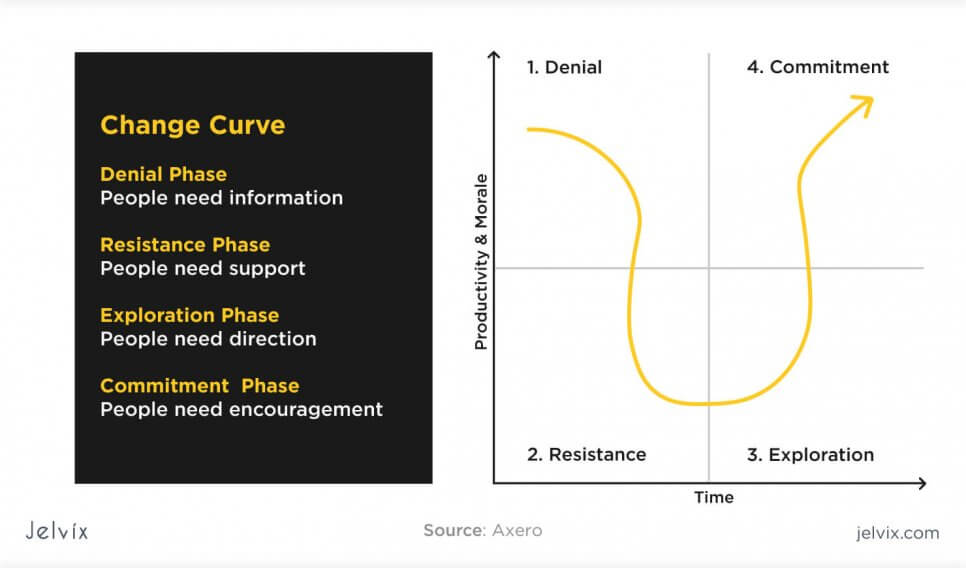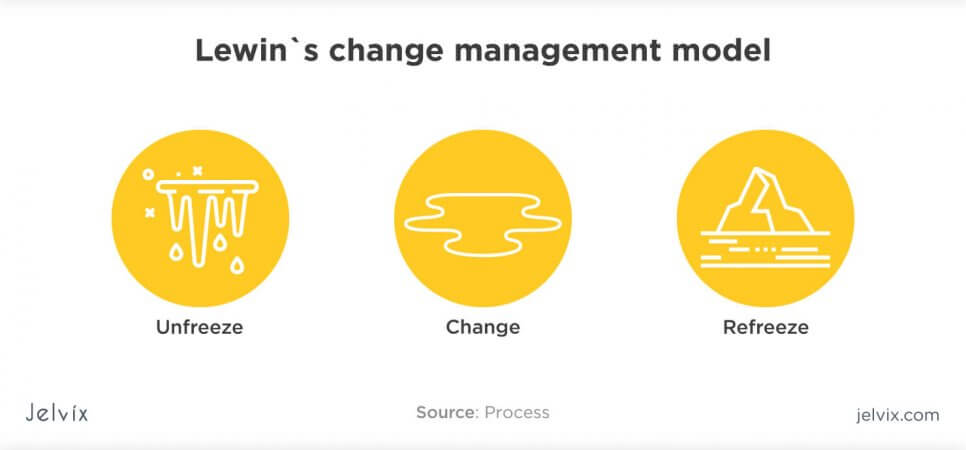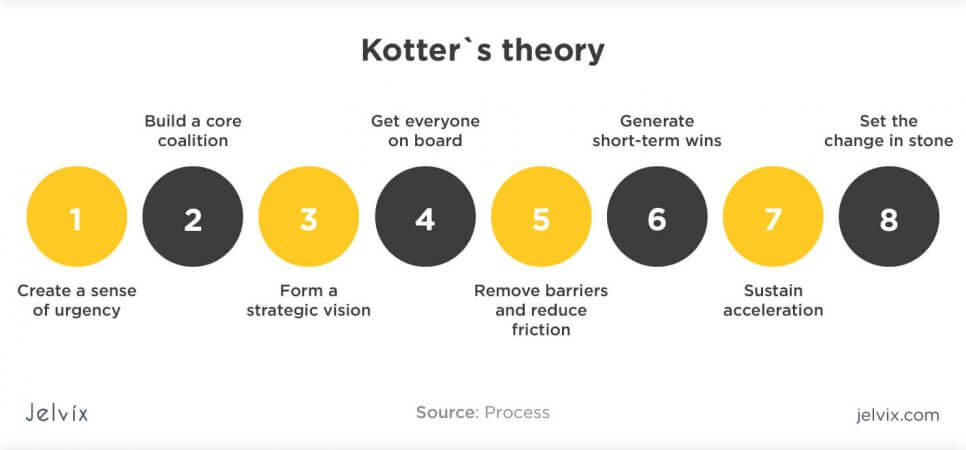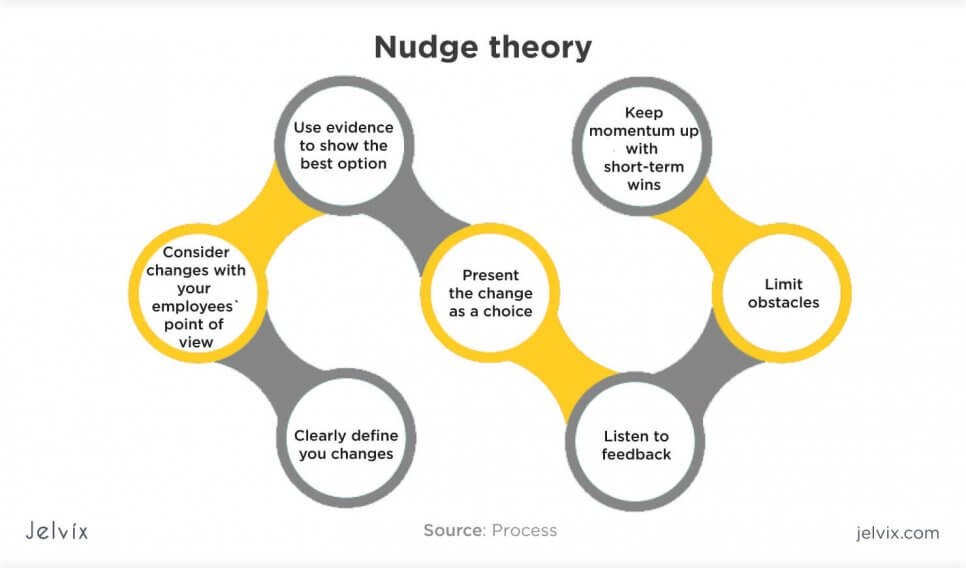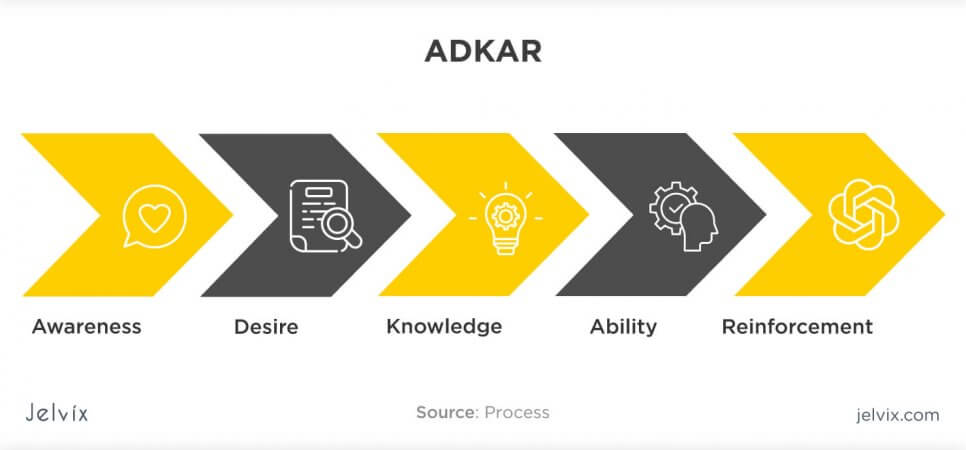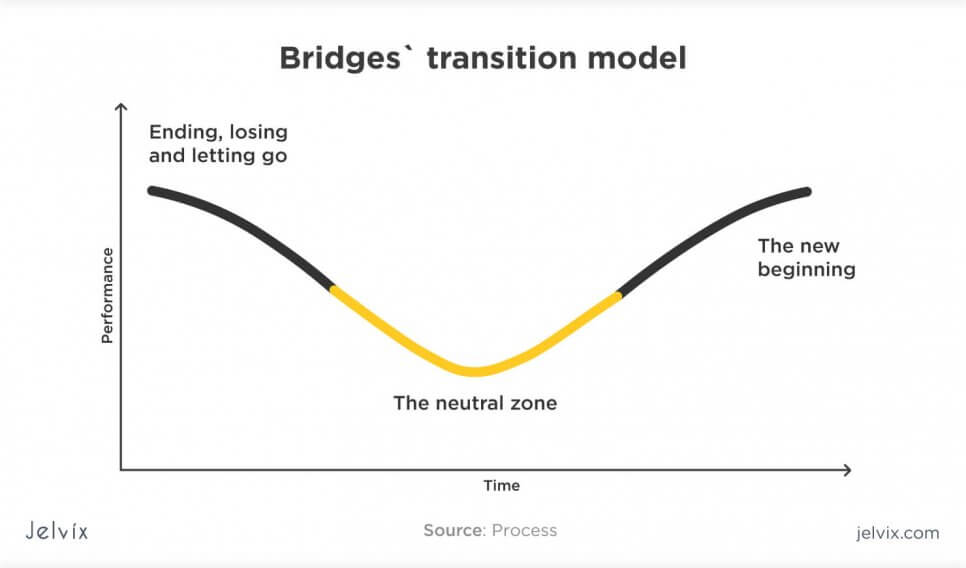Organizations are bound to change. Companies need to take on new challenges, develop innovative products, change their sizes, and niches. If there’s no program to support these changes, new projects are likely to fail. According to McKinsey, among projects that didn’t have a change management program in place, more than 70% fail.
The usage of digital software makes building and tracking change easier. Organizations have access to real-time reports, quantitative data, and profound decision-making insights. However, digitalization also makes changes more needed than ever. Now companies need to constantly change their marketing and advertising strategies, release new products, and come up with competitive advantages. If a business doesn’t have a change management plan, it’s likely that the company is already falling behind.
In this article, we’ll talk about the essence of change management, methodologies, and metrics. You’ll be able to start implementing change management in your company and have a long-term strategy for facing new challenges.
What is change management?
Change management is a collection of practices that are implemented to prepare, train, and support teams during changes and shifts in organizational processes. It’s a structured methodology that involves employees, managers, and stakeholders (investors, partners). The purpose of change management is to make sure that employees understand the scope of the change and have their roles during its implementation.
Main principles of change management
Change management is done in 9 steps that cover preparation, research, team training, metrics, and the creation of a sustainable system. Let’s take a look at what change management techniques and principles should be implemented in order to build a sustainable change – not a one-time effort.
Identifying the issue
Before you motivate your entire team to embrace the strategic change, you need to understand it first. If the management fails to identify the goals of the transformation, the team will not get on board easily. This is why the first and most important step in change management is to define the problem.
- Research similar changes performed by competitors. Check if companies in your field implemented similar transformation, follow their social media as well as LinkedIn and Twitter accounts of their employees. By tracking their online updates, you can spot some inside insights.
- Back your insight with statistics. Before you share your change objectives with employees, you need to make a strong case. Use reports of trusted sources (Gartner, McKinsey, PwC, and others) to define the directions in which your company should be growing.
- Plan what resources you need to execute change. Will your in-house resources be enough? Perhaps, you need partners like a software development and testing team to help you out? Think about change implementation.
- Listen to experts. If you think that you planned your change in detail, you likely need another. Contact experts in the field and ask them about the feasibility of your plan.
Changing processes from the top
Your change management plans should start from management. You need to think about which methodologies and tools to implement. Here’s a checklist that should help you analyze your management strategy during embracing changes.
- Divide the responsibility: change management isn’t a solo project. You need to establish a management team and assign a responsible team for each process.
- Define the positive outcome. Determine what you’d like to achieve and write a step-by-step plan. At this point, you should also define benchmarks for all involved processes.
- Manage risks. List out all potential obstacles and assign each of them a score from 1 to 10 according to their likelihood. It will help you understand what to watch out for most likely.
Clear communication
Your employees should be aware of what changes are happening within the company. Every team member has different preferred communication mediums and strategies, which is why it’s important to use different ones to present your ideas efficiently. Here’s a rundown of change management methodologies for smooth communication.
- Combine digital and offline methods. Emails, blogs, explanation videos, and Slack channels are a must in your communication of a change strategy. However, traditional methods – meetings and discussions in the office – shouldn’t be disregarded either. It’s often the case that even in-house teams mostly communicate via Slack, dedicating very little time to personal interactions, which is a mistake.
- All communication should be two-sided. All platforms should allow employees to leave comments, suggestions, and rate management activities. Encourage team members to give feedback by running surveys and sending out virtual forms.
- Make communication personal. Explain to every team member how changes will affect their current position, paycheck, skills, career growth, work-life balance, and other important aspects.
Employees often feel threatened by changes, as they don’t know what to expect. By implementing an efficient communication strategy, you can remove doubts and increase the team’s motivation.
Regular training
Change management requires employees to acquire new skills. The company should oversee the process, offering team members learning management systems, e-books, and educational videos. Take a look at content that is essential for successful change management.
- Learning management system: you can buy a ready Learning Management System with templates for sources and ready-to-use functionality or build a custom LMS, tailored for your company or your management process. Custom LMS is usually more efficient in the long run; ready solutions are cheaper.
- Explanatory videos: you should invest a couple of hours in recording your best practices and preparing commentary. Unlike text wikis, explanatory videos are more engaging and easier to follow.
- Peer-to-peer documentation: if some of your employees are experts in a particular field, ask them to document their best practices. Sure, it should be paid as a business task.
Providing support and appreciation
Encouraging your employees through the process of embracing change is the key to keeping their motivation and creating a collaborative atmosphere. Change management requires team members to be a lot more engaged in communication and learning, and these activities often feel like useless unpaid work. Here’s a couple of things you can do to show appreciation for additional work.
Challenges of change management
Even if you follow all decided stages of change management, implementing innovation is not easy. It’s possible that you will face concerns from your team, lose sight of your objectives, or experience a lack of proper skills. Here are four main challenges that you should be ready to face before embarking on the journey of change execution, digital transformation, or global expansion.
Employee Resistance
During change implementation, your team will likely be divided into three groups: Observers, Advocates, and Rebels. Each of them will react differently to shifts in organizational processes and threats, and you need a separate communication strategy for every group.
- Observers: these employees usually don’t embrace change actively; instead, they watch how changes impact advocates, tracking the outcome;
- Advocates: these are the most active support center during your changer management process. These change management principals will embrace new initiatives and serve an example for less enthusiastic adopters.
- Rebels: this most skeptical group of employees will resist changes either openly (complain to management or discuss concerns within the team) or be hesitant about complying with requirements.
The resistance of rebels and the passivity of observers are a huge challenge in approaching change management. If the fraction of skeptical employees get higher, advocates will likely get more skeptical, too – and you risk losing your support center.
Planning
If a team and management don’t have a coordinated system of actions in place, the change management process will be sabotaged. To ensure this doesn’t happen, you need a change management plan. This document describes all change-related activities and responsible people who oversee the processes. The plan describes project requirements, budget, deadlines, schedules, risks, task priorities, teams that are involved in the process.
Usually, parties involved in planning include a team, manager, project sponsor, customer, and stakeholders. Plans are created at the beginning of product development and can be updated at any point in the project.
Lack of Communication
There’s a mistaken belief that you can create a single communication for the entire change implementation process and use it to resolve all the critical situations. In reality, the needs of your team are constantly changing as your project is growing.
In change management communication, employees go through four key stages of communication.
- Denial: employees will refuse the changes and try to delay the effects of their implementation. The first stage is handled by communication. The management has to show how other teams are handling similar processes, set goals, and show where to get assistance if there are questions or problems.
- Resistance: at some point, people realize that change is definitely happening and can’t be reversed. At this point, they will start having realistic concerns. This stage is faced with support: you need to talk about financial and professional security, show plans B, and provide feedback. This is where you should pay attention to implementing learning management systems and communication software. You need to be constantly available for your team.
- Exploration: when people come to terms with change, they will start looking for new possibilities. This a positive development – all you need is to show the direction in which to grow. At this point, you need an expert team that will consult your innovation implementation. For instance, if it’s digital transformation, you can consult a software development team.
- Commitment: change becomes a lifestyle, and you need to show your team that their efforts pay off. Here, team meetings and bonuses can help to demonstrate the progress and inspire team members to continue working.
We could’ve gone through the other 10 principles of change management – there are a lot of details that should be minded in the change management process. However, we stopped on the fundamental aspects – and now, let’s move on to practical implementation.
Change management methodologies
When companies invest in developing change development strategies, it pays off. British Airways developed a clear change management method that helped optimize their services and drive $284 million of revenue. The company had a clear system, which is why their transformation was so successful. Let’s take a look at the most efficient method of implementing and measuring change.
Lewin’s change management model
This model is based on three key stages of approaching change: unfreezing, changing, and refreezing. Let’s take a look at each of these phases of this change management technique.
- Unfreezing processes: the company takes a look at existing processing, unfreezing all underlying details, examining problems, detecting bias, and collecting statistics. This stage is called unfreezing because you are disassembling your processes at many little tasks and looking at each of them individually.
- Changing. Once your processes are in the fluid state, you should begin to introduce change. This is where education and training come in. You start adding new skills to your team, look for outsourcing partners, and implement changes.
- Refreeze: once the changes start working, you need to structure them. At this stage, you document everything that has been done, take a look at statistics, and boil practices, formed during the change process, down to a method.
The McKinsey 7-S model
McKinsey created a more complex model to ideate and implement changes. This method takes into account all aspects of the company’s functionality. All the seven factors, described in the model, are intertwined, so if one isn’t working properly, it will sabotage the progress of the entire process.
The seven components of the 7S change management methodology are strategy, systems, structure, staff, shared values, style, and skills.
You don’t have to approach all these factors in a particular order, as soon as you take care of all of them.
Strategy
You need to assess your current strategy and create a new one if the existing one doesn’t correspond to your companies needs. You can do this by asking yourself and your team four simple questions.
- What are the goals of your change implementation?
- What’s the strategy for achieving these objectives?
- How will your company be competitive?
- How is your strategy applicable in the future, according to trends and predictions?
Systems
Turning processes into a system is a crucial task for any successful company. All effective practices should be documented and turned into a sustainable system. McKinsey approaches the system-establishing process in the following way.
- Defining the main system in your company (finance, technology development, communication, HR, marketing, meetings, documentation).
- Storing all successful processes and making sure they are accessible to the entire team.
- Updating all processes and methods. Systems tend to get outdated if there’s no frequent revision.
- Evaluating the efficiency of the system. Systems that you once thought to be successful might, in reality, not work as well anymore. Metrics and statistics will help to understand the current situation.
Structure
A lot of managers make a mistake of confusing strategy and structure or replacing one with another. Even if you already defined your change process step by step, you still need to know the anatomy of your processes. Here’s a couple of questions that will help you examine and define your team’s structure as you embrace changes.
- What’s your team structure: departments, units, individual tasks?
- Do you have a hierarchy, and which is it?
- Who organizes, manages, and evaluates your departments?
- Who oversees the organization of individual employees?
- How can a team member organize himself or herself without a manager’s help?
- How do teams communicate with each other?
- How do users communicate within a single team?
Staff
Structure evaluation is closely related to staff analysis. You need to constantly evaluate the efficiency of your team and the relevance of current positions.
- Which positions are currently filled in the team and which still need to be closed?
- What skills does each position contribute to the company?
- Is there any skill that your team is currently lacking?
- Who would be your next hire?
Record shared values
Changes should stem from the beliefs and priorities that your company has built up to this moment. This is where your corporate culture is important: you need to understand how changes contribute to your existing values and what should be changed.
- What are your values?
- What’s your company and team culture?
- Is team culture different compared to the company culture?
- Does the team know the company values and follow them?
- Does the management treat the company values seriously?
- What can you do to make your company values more relatable to your team?
Style
This is where your staff and company culture come together. Here, you need to focus on your leadership and communication style. It’s important that you gather statistics and feedback because our own idea of the leadership style often tends to be idealistic.
- Who manages your teams and departments, and how is it done?
- How actively do your managers interact with team members?
- Does management communicate within itself?
- Is your cooperation style more collaborative or competitive?
Skills
You need to evaluate which competencies your company currently possesses and if they align with the chosen change direction. Here’s, as usual, a list of questions that will help you get a full picture of your team’s skill set.
- Do you have the necessary skills in your team to carry out existing tasks?
- Is the quality of your team’s skills enough for your current workload?
- What skills are missing?
- How will your skill needs change during and after change implementation?
- What are the skills that you expect to have at your disposal after you’ve implemented the changes?
- Do you have quantitative data to prove skill quality?
The 7S model is powerful because it encourages business owners and managers to take a deeper look at resources at hand and have a helicopter view of their organization. You don’t have to analyze all seven factors at a time, but it’s important that you eventually assess all the company’s processes.
Kotter’s theory
Kotter’s method takes a change-with-a-human-face approach. The theory focuses on the team behind change implementation and divides the process of change implementation into eight fundamentals of change management.
- Developing and maintaining a sense of urgency: your team should get a clear sense that a change is needed. You need to start discussing problems that will be reformed, competitors who already started moving in the needed directions, and new possibilities on the market. Ideally, this should be done at least a month prior to starting the change implementation.
- Creating a loyal coalition: you need to gather a core group that will support the change. Be sure to talk to people of different skills, experience levels, and positions. You need to have people who support you among management and other employees.
- Establishing a bigger-picture vision: you need to boil your motivations of change process and expectations into one or two sentences. This will help you establish a coherent view of the situation.
- Bringing the entire team in: at this point, you should focus on convincing skeptics and observers to join the change implementation. It’s done on team meetings, reports, and by letting convincing third-party experts join the team.
- Taking off barriers: it’s helpful to conduct surveys and find out what’s holding your team from their optimal productivity. After you find out what to fix, you can remove these obstacles one by one.
- Encouraging the team’s small wins: celebrating intermediate success provides that encouragement that we talked about during our communication analysis.
- Getting faster: when the process has already been established, it’s time to optimize your systems. At this point, your focus is not just delivering the result, but also shortening the required time.
- Finalizing the changes: it’s time to document all best practices and use them as established systems.
This system gives management a clear step-by-step algorithm for change implementation, and it’s universal. No matter which changes you implement, be it technological or organizational, you can implement these stages in your team.
Nudge theory
According to the nudge theory, the most effective change management isn’t the one that’s coming from above, but from bottom-up. To make sure this happens, companies using nudging: a strategy of encouraging employees to take the right direction to recognize the faults in the existing system (nudges). It’s more of a theory rather than an established method, but it’s often used in management and marketing, and it often is considered to be one of the most efficient ones.
To implement nudging, you can follow a simple algorithm:
- Define the direction in which you’d like to change your company;
- Imagining the ways in which your employees can see changes;
- Create scenarios in which your employes would have to consider changes;
- Talk to your team and find out what was bothering them lately;
- Encourage education and exploration.
Nudging is successful if you know your team and their needs. You need to encourage exploration, and creative thinking – this way, employees might be the first ones to suggest changes that you perhaps don’t even think of.
ADKAR
ADKAR is a lesser-known set of change management principles and methodologies where first letters stand for Awareness, Desire, Knowledge, Ability, and Reinforcement. These aspects refer to a team’s capacity to understand the need for changes, desires to participate in the implementation, knowing how to act, and using their skills to start and sustain changes.
Let’s take a quick look at each of these components to understand how to implement this model practically.
- Awareness: here, you explain to employees your motivation to implement changes, show statistics, and demonstrate the list of processes that you’d like to reform.
- Desire: appealing to rational thinking of your employees isn’t enough to comply with them to adopt changes. You also engage their emotions, showing the benefits of adopting new practices, and help them feel like they are appreciated.
- Knowledge: all change implementation participants should know how changes will be executed and understand their roles in the process;
- Ability: you should prepare learning materials for your employees and assign mentoring to senior team members. This will help you increase a team’s ability in the face of changes.
- Reinforcement: you need to reward your employees for their enthusiastic and productive actions. The change should feel like a driver to self-improvement and career growth, not like a bunch of additional work.
ADKAR gives clear guidance on approaching change and guiding your team. It’s very specific and easy to implement. What we appreciate the most about this methodology is its universality – ADKAR can be adapted to small changes and incremental shifts alike.
Bridges’ transition model
Bridges’ method focuses less on rational aspects of accepting change, and more on emotional aspects. The model describes ways in which people react to changes and gives companies guidance on managing these emotional reactions.
What are the key principles of change management, according to the model?
- Ending, losing, and letting go. In this stage, the company should focus on highlighting the importance of the change, terminating old practices, and installing new approaches instead. It’s not going to be a complete transformation yet, but the employees already should see the first results of changes. Since changes are always associated with losses, company managers should think of ways to compensate for these risks.
- The neutral stage. This stage described the period when old practices were already demolished, but the new ones weren’t properly installed yet. For this stage, business owners and managers should focus on addressing concerns regarding the adoption of new methods and measuring outcomes.
- The new beginning. This was the reward stage when the changes were already accepted by the team, and it’s time to see the results. At this point, the team fully embraced new practices and started seeing positive outcomes. It’s important not to lose the positive momentum established during change implementation. Managers should offer new directions in which the team should move.
Bridges’ transition model highlights the ways in which employees’ feelings fluctuate as they move through various change-acceptance stages. You should remember that each stage requires a separate strategy and reaction plan.
Conclusions
Change management strategies and methods help companies to plan out their actions and present teams with a fully flashed-out action plan. When you know your objectives and have a step-by-step algorithm in place, it will be easier to convince employees to accept new practices.
As a software development company, we are on the frontline of implementing changes. We constantly see how businesses undergo digitalization, switch from old instruments, and tech stacks to modern tools. In many years of innovation experience, we have our own method of bringing changes. If you have a transformation project but aren’t sure how to bring it to your team, contact our experts. We’ll share our change implementation experience, best methods, metrics, and tools.






